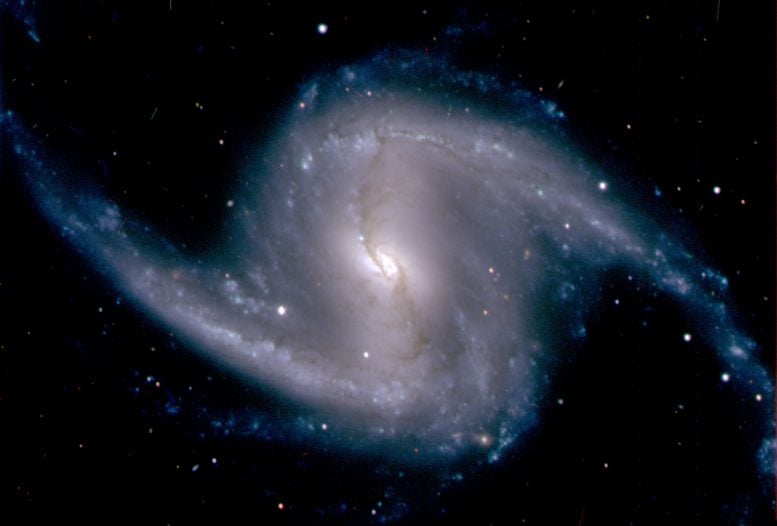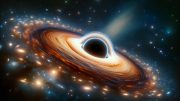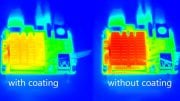
Zoomed-in image from the Dark Energy Camera of the barred spiral galaxy NGC 1365, in the Fornax cluster of galaxies, which lies about 60 million light-years from Earth. Credit: Dark Energy Survey Collaboration
Located on a mountaintop in Chile, the newly-constructed Dark Energy Camera is the most powerful sky-mapping machine ever created and has captured and recorded its first rays of light from distant galaxies.
When the Dark Energy Camera (DECam) opened its giant eye last week and began taking pictures of the ancient light from far-off galaxies, more than 120 members of the Dark Energy Survey (DES) eagerly awaited the first snapshots. Those images have now arrived.
Though scientists at Fermi National Accelerator Laboratory lead the project, they count among their number the Santa Cruz-SLAC-Stanford Consortium, the official name for a small, tight-knit group of scientists who helped make the pictures happen.
The images captured by the 570-megapixel camera, the largest of its kind, are the earliest fruits of years of labor: eight years of planning and constructing the instrument and then transporting it to a mountaintop in Chile where it was mounted on the 4-meter Victor M. Blanco Telescope located at the National Science Foundation’s Cerro Tololo Inter-American Observatory.
In that sense, these first images are sweet indeed. David Burke, SLAC physicist and member of the Kavli Institute for Particle Astrophysics and Cosmology (KIPAC), a joint SLAC-Stanford institute, leads the local DES contingent. Burke sees in the first light pictures hard evidence that members of his group are doing good work. For example, he notes, “Professor Rebecca Bernstein of UC Santa Cruz designed the optics for the camera…a difficult but critical system that the first images show was done exceptionally well.”
Calibration & Focusing
The first light images from DECam are visually beautiful, but more importantly the images reassured Burke and Aaron Roodman, another SLAC physicist and KIPAC member, that the camera systems they worked on will supply good data for research. Burke’s subgroup deals with photometric calibration – meaning they set the scale by which all photons of light gathered by the camera are measured, so that results remain consistent.
“We’re defining a set of calibration objects – stars that we know very well,” he said. DES researchers will compare a DECam image of one of the known objects to a DECam image of, for example, an unknown galaxy cluster. “If we know the brightness of a certain star and it hits the camera with 10 million photons while this unknown cluster hits the camera with five million photons, that tells us how bright the cluster is.”
Roodman’s subgroup is working on the focusing system, “a closed feedback loop of eight CCDs,” he said, charge-coupled devices holding a total of 33.5 megapixels of dedicated sensors. Between camera shots these sensors will check certain stars, compare them to what the focusing system thinks they should look like, determine if the camera is still properly aligned and focused, and give the word to adjust it or not before the next shot. “All in eight seconds.”
The Hunt for Dark Energy
According to Burke, “DES is turning the corner to science,” and the members of the Santa Cruz-SLAC-Stanford Consortium are viewing the images as just a taste of the discoveries to come. The photos taken by DECam during the next five years will create a detailed survey of one-eighth of the sky, which DES researchers will turn into the best map to date of the dark matter in DECam’s corner of the universe.
The DES collaboration will then search the map for signs of the influence of dark energy, that enigmatic phenomenon that appears to be pulling the universe apart at a faster and faster pace. “We’re hoping to make the connection between dark matter, dark energy, and the way the universe evolved,” Burke said, and he and his team have some very specific contributions to make in that area as well.
Looking further into the future, several members of the local consortium also work on the development of the Large Synoptic Survey Telescope (LSST), for which the DES is paving the way. In preparation for the LSST they’ve been developing analysis techniques that can be applied to DES data as well, such as weak gravitational lensing. This is an important technique in which the gravitational force of foreground objects, such as galaxy clusters and the concentrations of dark matter in which they’re embedded, bend the light of more distant objects – but not cleanly. It’s like looking through a cracked picture window. The local DES contingent has been working on ways to map this web of dark matter “cracks.”
KIPAC members have also been working on simulations of galaxy growth during the history of the universe based on what is currently known – or theorized – about the universe. Comparing DECam’s findings to their simulations will help scientists adjust their models.
“KIPAC has a particular expertise in simulations and weak lensing techniques,” Burke said – an expertise nurtured in preparation for LSST, but which KIPAC is eager to use in service of the Dark Energy Survey.
Of course, many scientists involved in the effort would probably never have been drawn to astrophysics and cosmology without a much more basic appreciation of the night sky. DECam’s first images didn’t disappoint on that score, either.
“The images are breathtaking,” Roodman said. “Spectacularly good for first light images.”









interesting pics and info. but i did quit reading when the scientists titles became most of a paragraph. their title isnt that relevant to the article. waste of typing. but i did enjoy the pics. good job to those that are makin this happen
Dark Energy Survey (DES) enabled by Large Synoptic Survey Telescope (LSST) is interesting in the projection of galaxy NGC 1365 by the process called weak gravitational lensing used to detect dark energy. Gravitational lensing effect of Dark Matter splitts the light from the star in a kaleidoscopic panaroma due to its gravitational effect in the absence of viewing it directly. But in Dark Energy which is 73 percent of the universe and all pervading , the spot splitting of light will not work. The total dimming of light will help. 8 percent of the sky will be scanned for dark energy and photometric observations will be analysed. Dark Energy is something much more complicated and hard to explain since it is omnipresent. The density is also fantastic and it is filling entire vaccuum in space. When darm matter causes expansion of the universe by gravitational repulsion of galaxies, dark energy is filling the universe with incredible energy continously during the expansion. Enntropy law of the universe is going against the thermodynamic law because of the dark energy and it is applicable only for the visible energy and visible world and galaxies which are but miniscule of 4 percent only. Thank You.